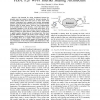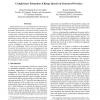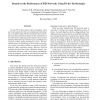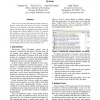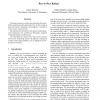P2P
2007
IEEE
14 years 10 months ago
2007
IEEE
— The demand for cheap broadband Internet for nomadic users has created a market for Internet sharing. WiFi communities which allow their users to share their wired Internet conn...
P2P
2007
IEEE
14 years 10 months ago
2007
IEEE
Maintaining desired data availability while minimizing costs is the primary challenge in designing P2P storages. Data placement schemes and data availability calculation methods a...
P2P
2007
IEEE
14 years 10 months ago
2007
IEEE
In this paper we propose fully distributed trustbased policies for p2p systems to regulate the exchange of different type of services and discourage misbehaviour. In a system of p...
P2P
2007
IEEE
14 years 10 months ago
2007
IEEE
Range queries are a very powerful tool in a wide range of data management systems and are vital to a multitude of applications. The hierarchy of structured overlay systems can be ...
P2P
2007
IEEE
14 years 10 months ago
2007
IEEE
Tit-for-tat is widely believed to be the most effective strategy to enforce collaboration among selfish users. However, it has been shown that its usefulness for decentralized an...
P2P
2007
IEEE
14 years 10 months ago
2007
IEEE
Structured overlay networks form a major class of peerto-peer systems, which are touted for their abilities to scale, tolerate failures, and self-manage. Any long-lived Internet-s...
P2P
2007
IEEE
14 years 10 months ago
2007
IEEE
Current P2P systems employ tit-for-tat strategies, where peers only upload when they are simultaneously downloading, to avoid free riding. We derive optimal tit-for-tat strategies...
P2P
2007
IEEE
14 years 10 months ago
2007
IEEE
Peers in peer-to-peer file-sharing systems cannot effectively share their files if they are poorly described. Terms one user employs to describe an instance of a file may not be t...
P2P
2007
IEEE
14 years 10 months ago
2007
IEEE
P2P
2007
IEEE
14 years 10 months ago
2007
IEEE
This paper proposes to utilize algorithms from the probabilistic graphical models domain for Peer-to-Peer rating of data items and for computing “social influence” of nodes i...
